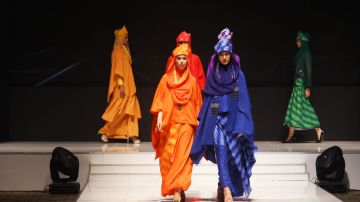15 Instances Where Indigenous Style Has Been Appropriated and Uncredited
Whether you understand it fully or not, cultural appropriation is a real thing and a real problem

Photo: Unsplash/Raden Prasetya
Whether you understand it fully or not, cultural appropriation is a real thing and a real problem. The Cambridge Dictionary, defines it as “the act of taking or using things from a culture that is not your own, especially without showing that you understand or respect this culture.” And a lot of times, it is marked by a dominant culture taking from one that has been colonized and oppressed — without regard, respect, or credit. To add insult to injury, once the dominant — more often than not white — culture reiterates these things, they are then seen as cool, edgy, and fashionable. While those of the originating culture are seen as foreign, backwards, “ghetto,” and un-American. Writer Jaya Sundaresh describes this perfectly in her article “Beyond Bindis: Why Cultural Appropriation Matters.” She points out Selena Gomez wearing a South Asian bindi (traditionally worn by Hindus and Jains) and what that really means:
“What makes the non-South Asian person’s use of the bindi problematic is the fact that a pop star like Selena Gomez wearing one is guaranteed to be better received than I would if I were to step out of the house rocking a dot on my forehead. On her, it’s a bold new look; on me, it’s a symbol of my failure to assimilate. On her, it’s unquestionably cool; on me, it’s yet another marker of my otherness, another thing that makes me different from other American girls. If the use of the bindi by mainstream pop stars made it easier for South Asian women to wear it, I’d be all for its proliferation — but it doesn’t. They lend the bindi an aura of cool that a desi woman simply can’t compete with, often with the privilege of automatic acceptance in a society when many non-white women must fight for it.”
The celebrity world isn’t the only segment of society guilty of cultural appropriation. The fashion world has long been guilty of stealing culture in the name of wearable art. So much so, that we wanted to point out 15 blatant instances and discuss each, so we can all better understand how cultural appropriation operates, and help dismantle it.
wp_*posts
Victoria’s Secret Misusing War Bonnets — Multiple Times
So this happened last night …
Victoria's Secret model Nadine Leopold wore a Native American headdress and clothing. The #VSFashionShow has faced backlash in the past for culturally appropriating and sexualizing Native American culture. pic.twitter.com/QSYlW9KlrG
— AJ+ (@ajplus) November 21, 2017
Some companies will appropriate the aesthetics of another culture, apologize for doing so, and then do it again, thinking no one is going to notice or say anything. Take Victoria’s Secret, for instance. In 2017, it sent a white, model down their runway in their version of an American Indian war bonnet (a.k.a. headdress). This was five years after supermodel Karlie Kloss made the exact same mistake during the popular, televised show. An apology was made, that portion of the show wasn’t seen on TV, but it happened again. This is especially problematic because there is the added layer of hypersexualization of Indigenous women, who already have a shockingly high rate of sexual violence and murder committed towards them.
wp_*posts
Urban Outfitter’s “Navajo” Print
Woah, I had to look that up – they settled in 2016. I hope they got a lot!. “There’s nothing honorable or historically appreciative in selling items such as the Navajo Print Fabric Wrapped Flask, Peace Treaty Feather Necklace, or the Navajo Hipster Panty” https://t.co/S6v1FOpcri
— Caroline Yezer (@carolineyezer) June 15, 2019
This leads us to our next offender when it comes to cultural appropriation. Urban Outfitters has built an empire on taking fashion trends and feeding them back to the masses, often at a high price point. But American Indian style isn’t a fashion trend, it is the culture and identity of a community — one that is not for sale. The retailer caught heat for creating a variety of products, marketed as having a Navajo print, such as the “Navajo Print Fabric Wrapped Flask,” and “Navajo Hipster Panty.” The Navajo Nation sued Urban Outfitters in 2012, and a settlement was reached in 2016.
wp_*posts
Carolina Herrera Using the Serape Print
Carolina Herrera is confronting the messy reality of cultural appropriation https://t.co/vL9Qp7Na7s pic.twitter.com/wwD1kn5nyx
— Jezebel (@Jezebel) June 14, 2019
The next incident of cultural appropriation in fashion is by a brand that was once designed by a Latinx. Carolina Herrera, which is presently helmed by current creative director Wes Gordon, was once designed by the Venezuelan fashionista. Gordon, for the brand’s Resort 2020 collection, “took a Latin holiday,” per the company’s Tweet. This led to expensive garments using the traditional Saltillo serape print, copies of Indigenous Mexican embroidery, and no credit given to those who have created this inspiration for centuries.
wp_*posts
And Indigenous Embroidery
Unless @HouseofHerrera comes from Otomies, Nahuatls, etc. You couldnt be inspired on Carolina Herrera roots. You took Mexican Folk Art to make this collection happen give them credit! Or its called plagiarism. Period. https://t.co/lTlZ5BZz0z
— NL (@ManuelLOPEZSA) June 13, 2019
The Indigenous embroidery that Carolina Herrera copied is the tenangos of the Otomi people from Central Mexico. Taking something that is the culture, history, identity, legacy, and livelihood of an Indigenous group, not giving credit, then making thousands of dollars off this blatant theft is irresponsible and immoral. Mexico’s Minister of Culture, Alejandra Frausto Guerrero rightfully called out the luxury brand for its cultural appropriation.
wp_*posts
Chanel Boomerang
.@CHANEL says it "deeply regrets" boomerang controversy: https://t.co/iEFH5be4LD pic.twitter.com/KxMm5cbEj8
— WWD (@wwd) May 21, 2017
Chanel is a brand that has appropriated from other cultures, slapping their iconic CCs on clothing and items and then charging thousands of dollars for them. Just like they did with the boomerang, a tool used by Indigenous Australians, but which has been unearthed in several parts of the world, and dates back up to 50,000 years ago. The price tag for Chanel’s luxury version? Between $1325 and $1930 (depending on location).
wp_*posts
Mara Hoffman Copies Mexican Indigenous Clothing in 2009

Fashion designer Mara Hoffman also “borrowed” from Otomi culture and it’s iconic embroidery. This was done for her 2009 collection. Ironically, Hoffman sued Toms for stealing one of her prints in 2015.
wp_*posts
And Isabel Marant Did in 2015
Foto de la Banda filarmónica de mujeres de Tlahui con su Huipil y foto de la "blusa de diseñador" Diseño robado! pic.twitter.com/1l2dvxzC5R
— Susana Harp Iturribarría (@SusanaHarp) January 4, 2015
In 2015, designer Isabel Marant also decided to appropriate Mexican culture, by selling a blouse that was a knockoff of Mixe Indigenous huipil blouses from Santa Maria Tlahuitoltepec, Oaxaca — for $290. To add insult to injury, the brand Antik Batik sued Marant for using the design, claiming they had a copyright on it!
wp_*posts
KTZ Copied Inuit Designs
UK fashion house KTZ pulls 'stolen' Inuit design. Here's the full apology: https://t.co/nDFF4kRwCr pic.twitter.com/tcImMqzjQ2
— As It Happens (@cbcasithappens) November 27, 2015
London brand KTZ has had more than one instance of stealing and copying Indigenous designs. Specifically, it was a design from a sacred Canadian Inuit garment worn by a shaman named Ava — reproduced, changed a little, and made part of the brand’s Fall/Winter 2015 collection. Salome Awa, Ava’s great-granddaughter, complained about the appropriation and theft, which resulted in an apology and removal of the copycat garment.
wp_*posts
And The Rest of Their Collection Appropriated American Indian Designs
Not to mention the whole rest of @ktz_official's line is cultural appropriation to the extreme. Check it, Navajos: pic.twitter.com/CjnUUYU8Fd
— Adrienne Keene (@NativeApprops) February 19, 2015
That’s not to say the rest of their collections are free from Indigenous, American Indian cultural appropriation, as pointed out by Dr. Adrienne Keane of Native Appropriations clearly demonstrated on Twitter.
wp_*posts
Nike “Huaraches”
Huaraches?? I'm surprised no one is screaming cultural appropriation. My abuelita would roll her eyes (God rest her soul). Centuries of Mexican culture ripped off and profited by @Nike 🙄👎🏽 Kim Kardashian got slammed for kimono but this is ok? https://t.co/wJjHmmUNyQ @MailOnline
— Veronica (@vevecurl) August 30, 2019
In addition to brands making identical knockoffs of Indigenous huaraches, not giving credit to their origins, and jacking the prices up in an effort to cash in on a Pre-Columbian innovation and art, another just decided to steal the name and use the Tarahumara runners as inspiration for their shoes. Sneaker giant Nike named one of their products, which debuted in 1991, the Huarache.
wp_*posts
Michael Kors’ Luxury Jerga
Michael Kors sent Mexican-style jergas down the runway at his NYFW show, and people aren't happy about it. https://t.co/YrEDgsTXoX
— HuffPost (@HuffPost) September 14, 2018
Another example of a big fashion brand copying an Indigenous, often inexpensive garment or accessory, and charging exorbitant amounts for them is Michael Kors’ version of the old school, Mexican jerga. Also known as a Baja hoodie, the Baja jacket, or a drug rug, the woven hooded pullover became popular with surfers in Southern California during the 1960s and ’70s, and are also associated with hippies and stoners. But this garment is Mexican Indigenous in origin, and we need to remember this. Just because something has been a part of mainstream American/white culture for decades doesn’t negate it’s identity, culture, history, and ownership.
wp_*posts
Every. Year. At. Coachella.
Introducing #PopFeminist! Here, we discuss how to avoid cultural appropriation @ #Coachella. Watch NOW 👇👉 https://t.co/mOGGc7wncd pic.twitter.com/ibteFNHDSz
— Teen Vogue (@TeenVogue) April 21, 2017
The fact that the use of war bonnets, bindis, and other Indigenous and cultural items is called out every year at Coachella, and it still happens every year at the music festival is a problem. Wanting to look bohemian, earthy, or vintage-y is not an excuse for taking sacred elements of someone’s identity and parading around in them drunk. It’s disrespectful!
wp_*posts
Chanel “Cowboys and Indians” 2013 Dallas Show
Debate… Chanel's Native American headdress on runway raises eyebrows http://t.co/zxW34eAib9 #fashion pic.twitter.com/kI31XS5zQW
— Brindille (@Brindille_) December 13, 2013
Karl Lagerfeld was known for getting inspiration for his designs from all over the place, but homage or inspiration is not an excuse for being disrespectful to a culture via cultural appropriation. For his 2013/2014 Paris-Dallas Métiers d’Art show, Chanel sent “cowboys” and “Indians”—wearing war bonnets, face paint, Chanel’s version of Indigenous jewelry, specific embroidery, and geometric patterns reminiscent of American Indian work.
wp_*posts
Forever 21 Releases “Navajo” Collection, Including Underwear
It’s official: we’re going native this spring. We can’t get enough Navajo inspired jewelry and tribal print knits! http://bit.ly/gYKGnX
— Forever 21 (@Forever21) March 26, 2011
Forever 21 has a history of copying other people’s work and also releasing products that falsely appropriate and claim to be things they are not. Like all the “Navajo” items they made in Spring of 2011. Not only that, but this Tweet has them claiming to be “going native,” as if someone’s culture, history, and identity is a costume to put on, a trend to pick up and wear or something you suddenly become when you want to.
wp_*posts
DSquared2’s Offensive Fall 2015 Collection
#MFW – View all the runway photos of DSQUARED2 |@Dsquared2| Fall Winter 2015 on http://t.co/HFerKtJHNH pic.twitter.com/htWRXbwErt
— dudessinauxpodiums (@dessins_podiums) March 2, 2015
Ad Campaign | @DSquared2 Man Fall 2015 ft. Filip Hrivnak & Julian Schneyder http://t.co/D7ObVEKnCh pic.twitter.com/gQiuphif7u
— Julio Reyes (@Fashionights) July 4, 2015
For Fall/Winter 2015, the DSquared2 decided it was okay to not only appropriate and take credit for Indigenous Canadian culture and style, but to call their collection the ever-offensive slur (squaw) “dsquaw.” The design duo also took this ignorance into their Fall/Winter 2015 men’s collection, and their ad campaigns, but later apologized for their use of “inappropriate use of words.”

















